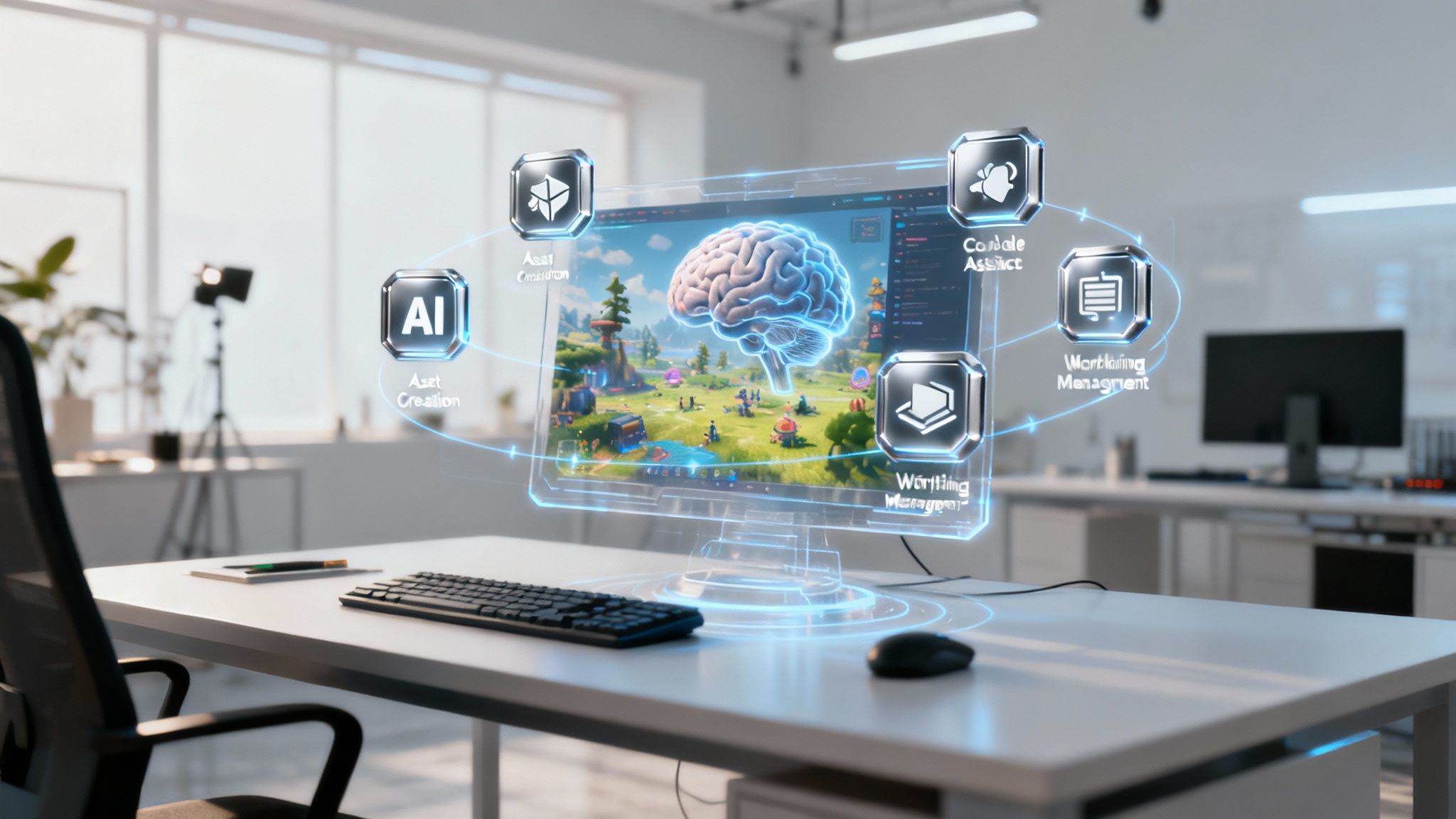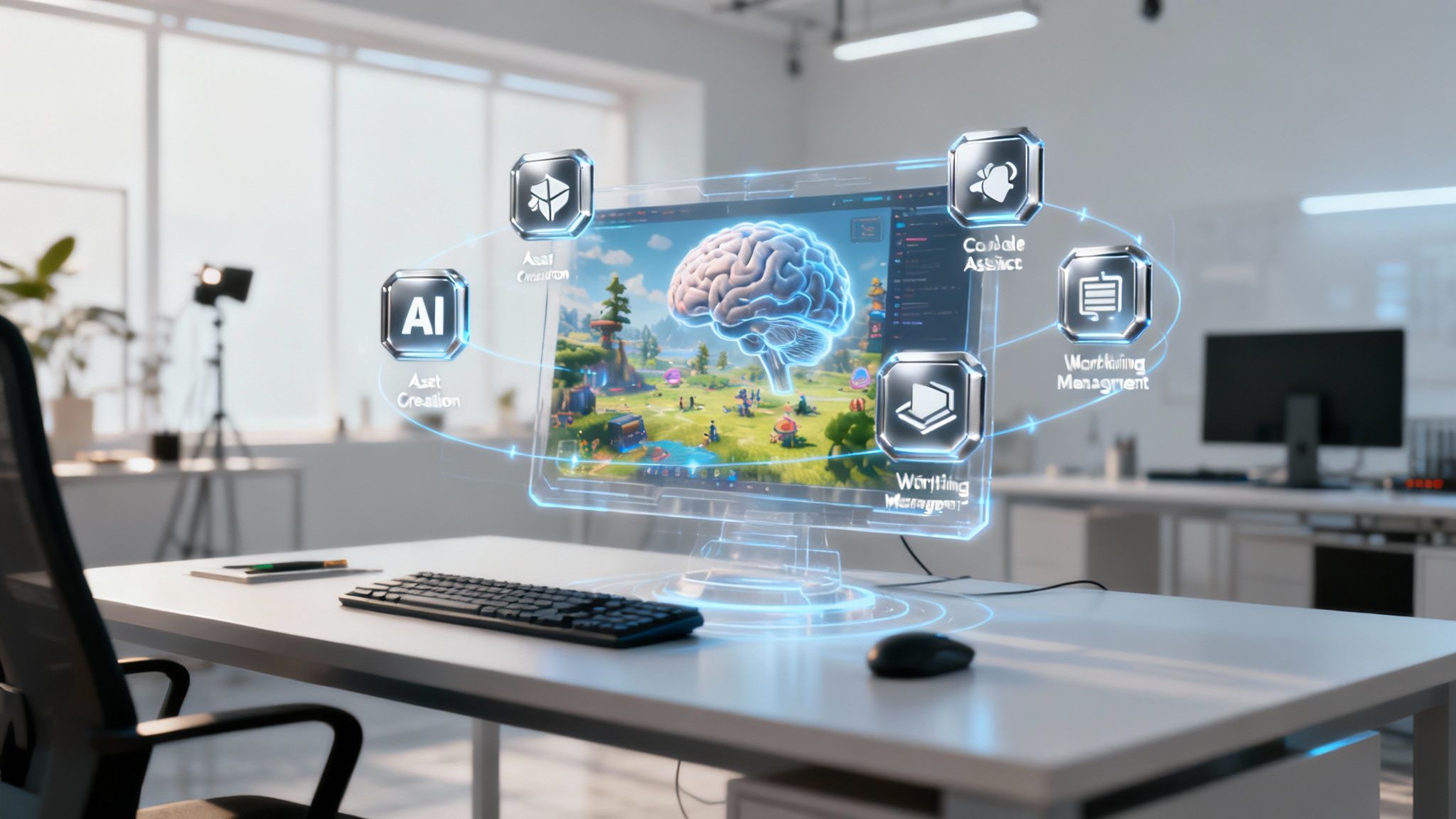Artificial intelligence has moved from a futuristic concept to a practical, pipeline-integrated reality in game development. For studios and creative teams, the challenge is not just adopting AI, but doing so responsibly and effectively. This guide is built for enterprises and professional creators, focusing on AI tools for game development that prioritise compliance, safety, and intellectual property protection. Our goal is to help your team find the right solutions to accelerate workflows while maintaining high standards.
We will explore a curated list of 12 powerful platforms designed to enhance every stage of visual production, from initial concepting and 3D asset generation to character animation and automated quality assurance. Each entry includes a detailed analysis, practical use cases, screenshots, and direct links to help you evaluate its fit for your specific pipeline. For a comprehensive approach to content and idea generation that can be adapted for various game development needs, platforms like Shortgenius offer additional creative support.
This resource moves beyond generic feature lists to provide honest assessments of each tool's capabilities and limitations. We provide the practical insights needed to integrate these platforms into your projects efficiently. Let's delve into the enterprise-ready solutions shaping the future of interactive entertainment.
1. Virtuall
Best for: Unified AI Asset Creation and Management
Virtuall establishes itself as a powerful Creative OS, meticulously engineered for studios and creative teams that demand both speed and control. It moves beyond single-purpose AI tools by integrating 3D model, image, and video generation into a single, browser-based workspace. This unified approach makes it one of the most comprehensive ai tools for game development, enabling teams to manage the entire creative lifecycle, from initial concept to final asset delivery, within one platform.
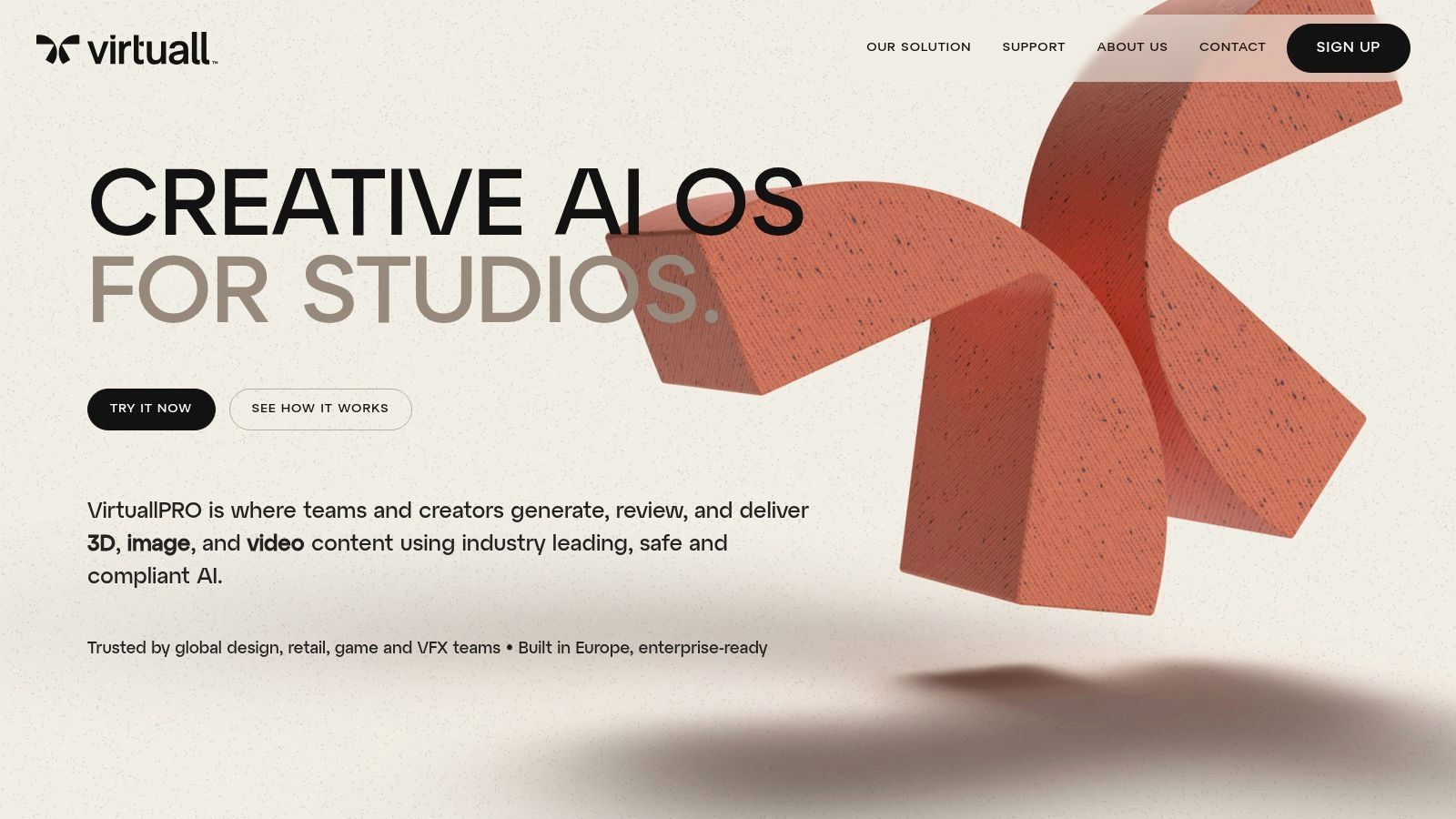
The platform’s core strength lies in its multi-engine architecture, allowing users to generate assets using several leading AI models side-by-side. This empowers art directors and artists to compare outputs, select the optimal style, and iterate rapidly without context switching or juggling disparate tools. For game developers, this translates into accelerated prototyping of 3D props, environments, and character concepts.
Key Strengths and Use Cases
Virtuall is built with enterprise-grade requirements at its centre. For studios where intellectual property and compliance are non-negotiable, it provides a secure, European-built environment with guaranteed ownership of all generated outputs. This focus on safe, compliant AI is a critical differentiator for professional game development pipelines.
Practical Use Cases:
- Rapid Prototyping: Generate diverse 3D asset concepts for in-game props or architectural visualisations.
- Marketing Asset Creation: Quickly produce high-quality images and video clips for promotional campaigns and social media.
- Collaborative Review: Utilise integrated annotation and Kanban-style boards to streamline feedback and approval cycles between artists, directors, and producers.
A unified AI token system provides essential budget governance, allowing managers to allocate and track creative spend across different projects and teams effectively. Access is enterprise-focused, requiring teams to book a demo for pricing and onboarding, which ensures a tailored setup. While AI outputs may still need expert refinement in tools like Blender or Maya, Virtuall provides an exceptional foundation for accelerating creative workflows and centralising asset management.
Pros:
- Unified workspace for 3D, image, and video AI generation.
- Enterprise-focused security with guaranteed IP ownership.
- Multi-engine flexibility for comparing and selecting the best outputs.
- Integrated collaboration and project management tools.
- Centralised budget control with a unified token system.
Cons:
- Pricing is not public; requires direct sales contact.
- Generated assets often need manual refinement in external DCC software.
Website: virtuall.pro
2. Unity Asset Store – Generative AI
For development teams already embedded in the Unity ecosystem, the Unity Asset Store’s dedicated Generative AI section is the most direct route to integrating AI tools for game development. This curated marketplace offers a wide range of plugins that install directly into the Unity editor, streamlining workflows for everything from procedural visual asset generation to creating intelligent, dynamic NPCs. Unlike standalone platforms, its key advantage is seamless integration, allowing developers to test and deploy AI functionalities without ever leaving their project environment.
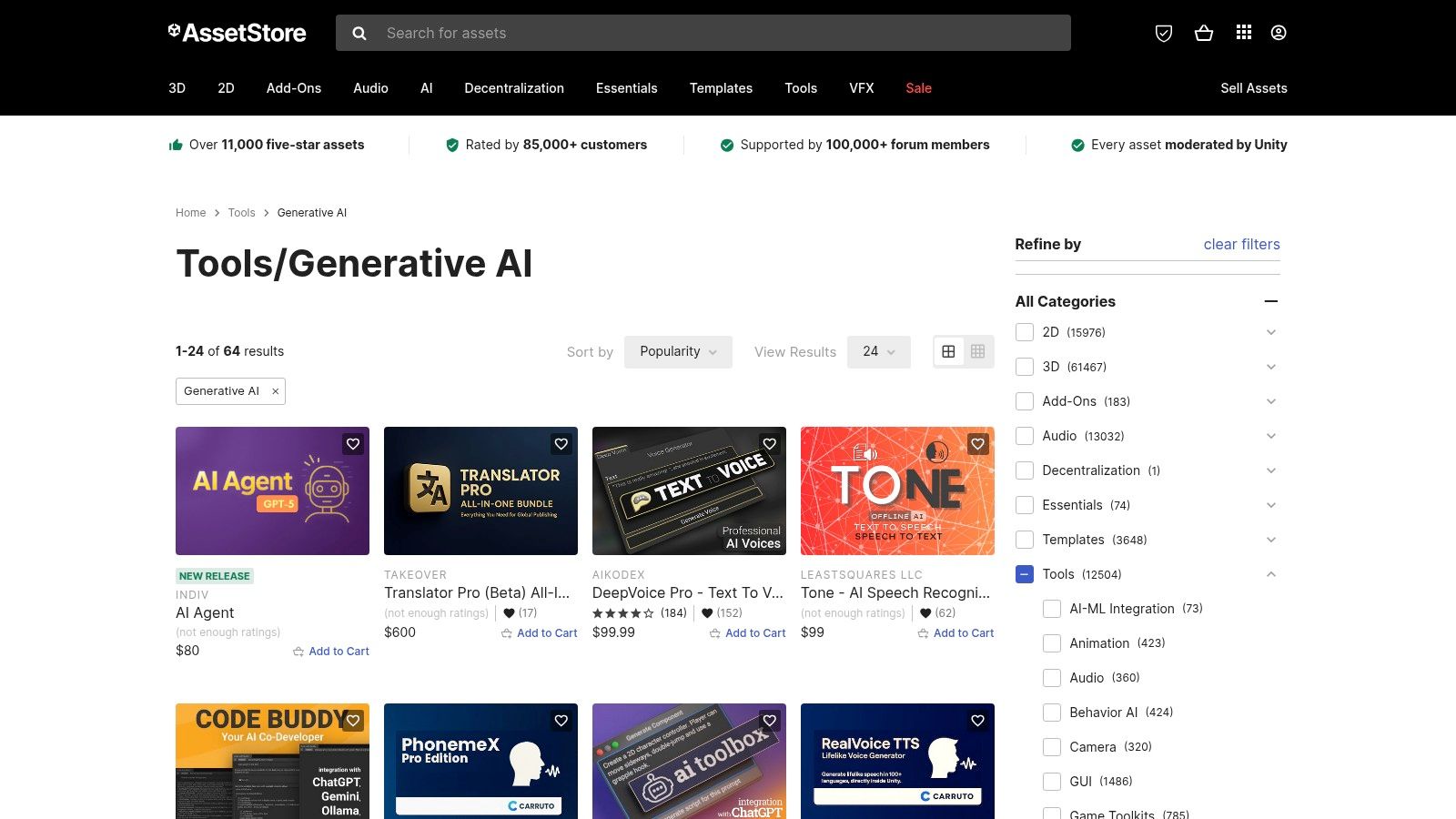
The platform stands out due to its robust user review system and clear version compatibility information, which helps teams vet tools before acquisition. Unity also enforces a responsible AI policy, requiring asset creators to disclose the use of generative AI in their listings, which supports enterprise compliance needs.
Key Considerations
- Pricing: A mix of free and paid assets, with most robust solutions requiring a one-time purchase. Prices vary significantly by publisher.
- Quality Control: While Unity moderates the store, the quality of individual assets can vary. Always check recent reviews, update history, and publisher responsiveness before committing.
- Usage Limitations: A crucial point in the terms of service is that content downloaded from the Asset Store cannot be legally used for training other generative AI models.
Website: https://assetstore.unity.com/tools/generative-ai
3. Epic Games Fab (Unified marketplace)
For developers building with Unreal Engine, Epic Games' Fab is the new centralised hub for assets, plugins, and AI tools for game development. As the successor to the Unreal Engine Marketplace, Sketchfab, and Quixel, it offers a consolidated library of resources, including a growing number of plugins that integrate Large Language Models (LLMs), AI coding assistants, and automation tools directly into the development pipeline. Its primary advantage is its deep integration with the Epic ecosystem, ensuring that purchased plugins and assets are readily available within the user’s Vault for seamless use in Unreal projects.
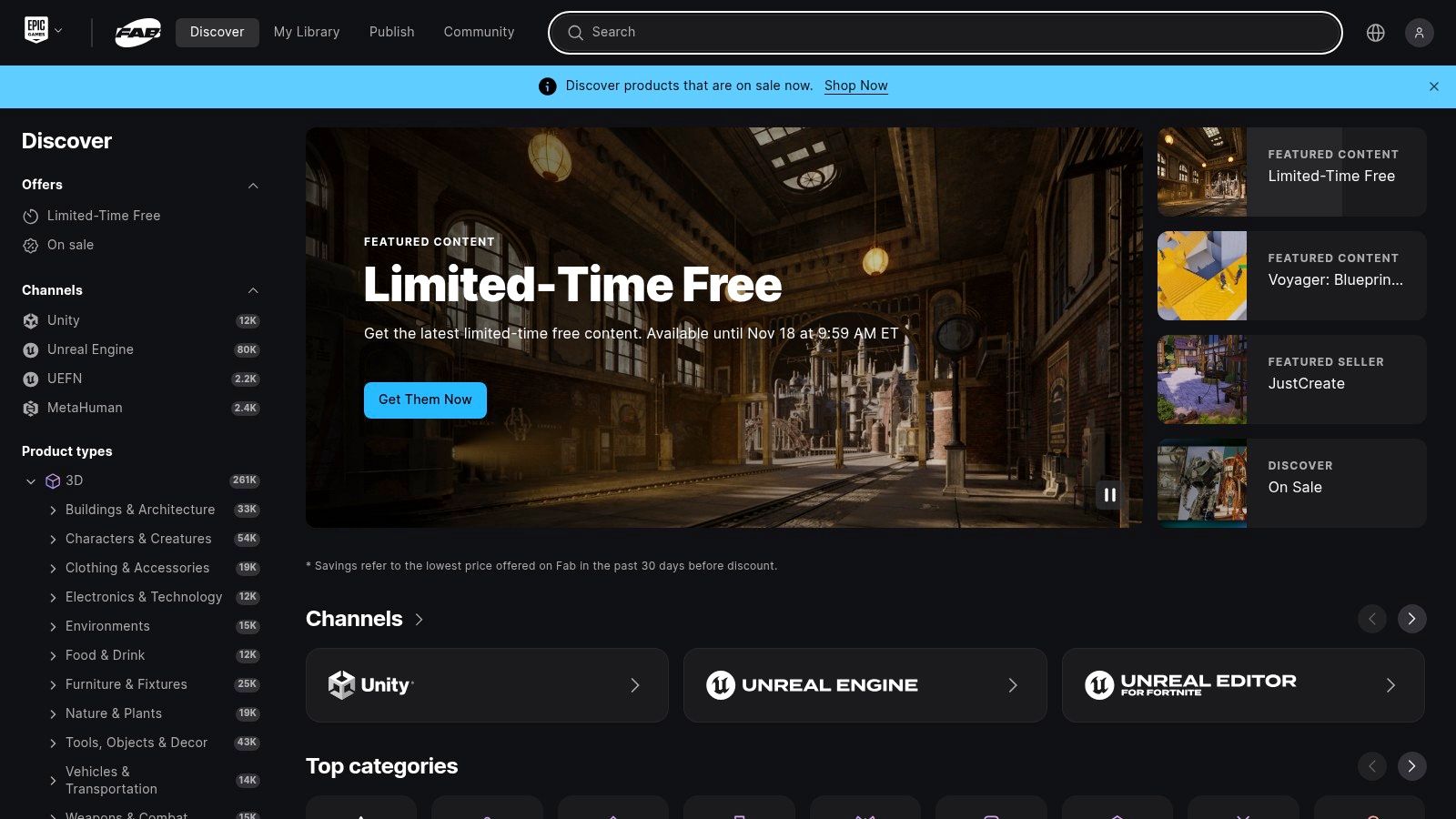
Fab stands out by unifying previously separate storefronts, creating a one-stop-shop for high-fidelity assets and the AI tools needed to manipulate or generate them. This ecosystem-centric approach simplifies licensing and asset management for teams. The marketplace provides clear commercial licensing terms, a critical factor for enterprise studios concerned with intellectual property and compliance.
Key Considerations
- Pricing: A mix of free and paid plugins, with prices for advanced AI tools typically ranging from tens to several hundred US dollars per licence.
- Quality Control: While Epic moderates listings, quality can be inconsistent. Teams should carefully examine user reviews, update frequency, and publisher support history before making a purchase.
- Usage Limitations: The migration from legacy stores is ongoing, so some familiar assets or plugins may not yet be available on Fab. It is important to verify compatibility before integrating new tools.
Website: https://www.fab.com
4. Inworld
Inworld offers a specialised AI runtime and toolset designed to bring NPCs to life with real-time, multimodal interactions. Its core focus is on creating dynamic characters that can converse, express emotion, and perform actions within a game world, moving beyond pre-scripted dialogue trees. The platform provides a complete character creation engine, including a visual graph system for behaviour design and low-latency, multilingual text-to-speech, making it a powerful solution for narrative-driven experiences.
The platform stands out because it is engineered for production-scale game pipelines, with SDKs available for major engines like Unreal and Unity. This focus on performance and ease of integration makes it one of the more enterprise-ready ai tools for game development when it comes to character AI. For a deeper understanding of its impact, you can learn more about AI's role in gamedev. The extensive public documentation and quick-start guides also lower the barrier to entry for development teams.
Key Considerations
- Pricing: While starter plans are available, production-level and enterprise pricing is not fully public. Teams often need to contact the sales department for a custom plan, which is typical for scalable B2B solutions.
- Integration: Requires technical implementation using their SDKs. While documentation is robust, it still necessitates development resources to integrate the runtime into a project.
- Specialisation: Inworld is highly focused on character and NPC AI. It is not a general-purpose tool for visual asset generation or code assistance; it solves a very specific, complex problem.
Website: https://inworld.ai
5. modl.ai
For studios focused on post-launch stability and game balancing, modl.ai offers a specialised set of AI tools for game development aimed at automating quality assurance and simulating player behaviour. The platform’s core strength lies in its AI-driven bots that can autonomously explore levels to find bugs, performance issues, and crashes. This significantly reduces the manual workload on QA teams, allowing them to focus on more complex, subjective testing scenarios. Unlike visual asset generation tools, modl.ai tackles the critical, often resource-intensive, testing phase of the development cycle.
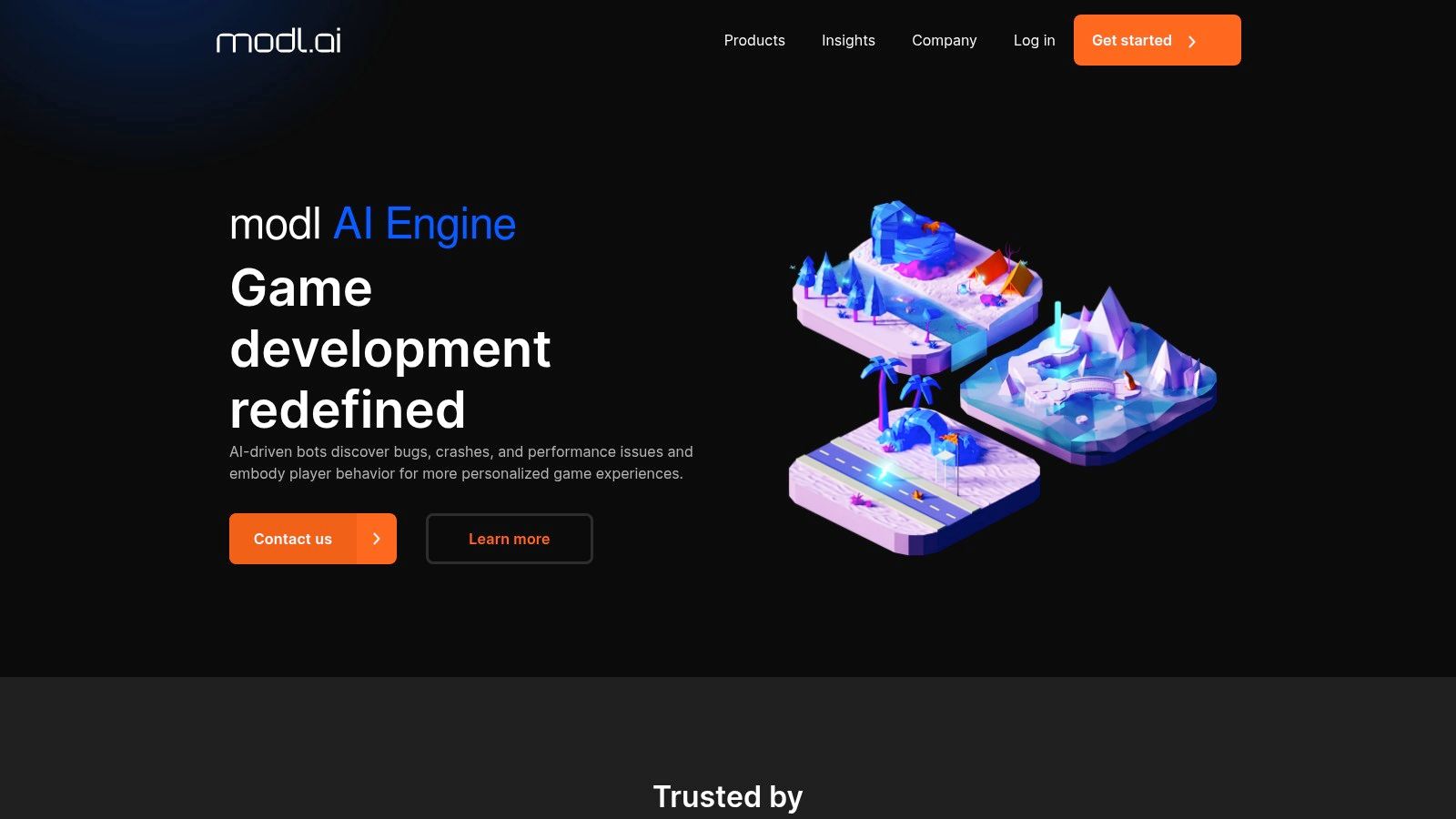
The platform is particularly valuable for its modl:play feature, which uses bots to simulate realistic player behaviours. This helps developers balance game difficulty, analyse player onboarding flows, and predict how design changes will impact user experience before an update goes live. The system can even be trained on data from live players, making its simulations increasingly accurate over time. This focus on behavioural simulation provides actionable design insights that are difficult to obtain through traditional testing alone.
Key Considerations
- Pricing: Access is enterprise-focused and requires direct contact with their sales team. There is no public, per-seat pricing model available.
- Engagement Model: Getting started typically involves a pilot programme or proof-of-concept project, which necessitates a more formalised engagement process compared to self-service platforms.
- Specialisation: The platform is highly specialised for testing, QA, and balancing. It does not offer creative or visual asset generation functionalities, making it a targeted solution for specific production needs.
Website: https://modl.ai/
6. Scenario
Scenario is an AI asset generation platform engineered specifically for game development workflows, focusing on creating stylistically consistent visual art. Its core function allows studios to train custom models on their unique art style, ensuring that every generated asset, from textures and sprites to concept art, aligns perfectly with the project's visual identity. This makes it an invaluable tool for maintaining a cohesive aesthetic across large-scale productions and is a key differentiator from more generalised image generators.
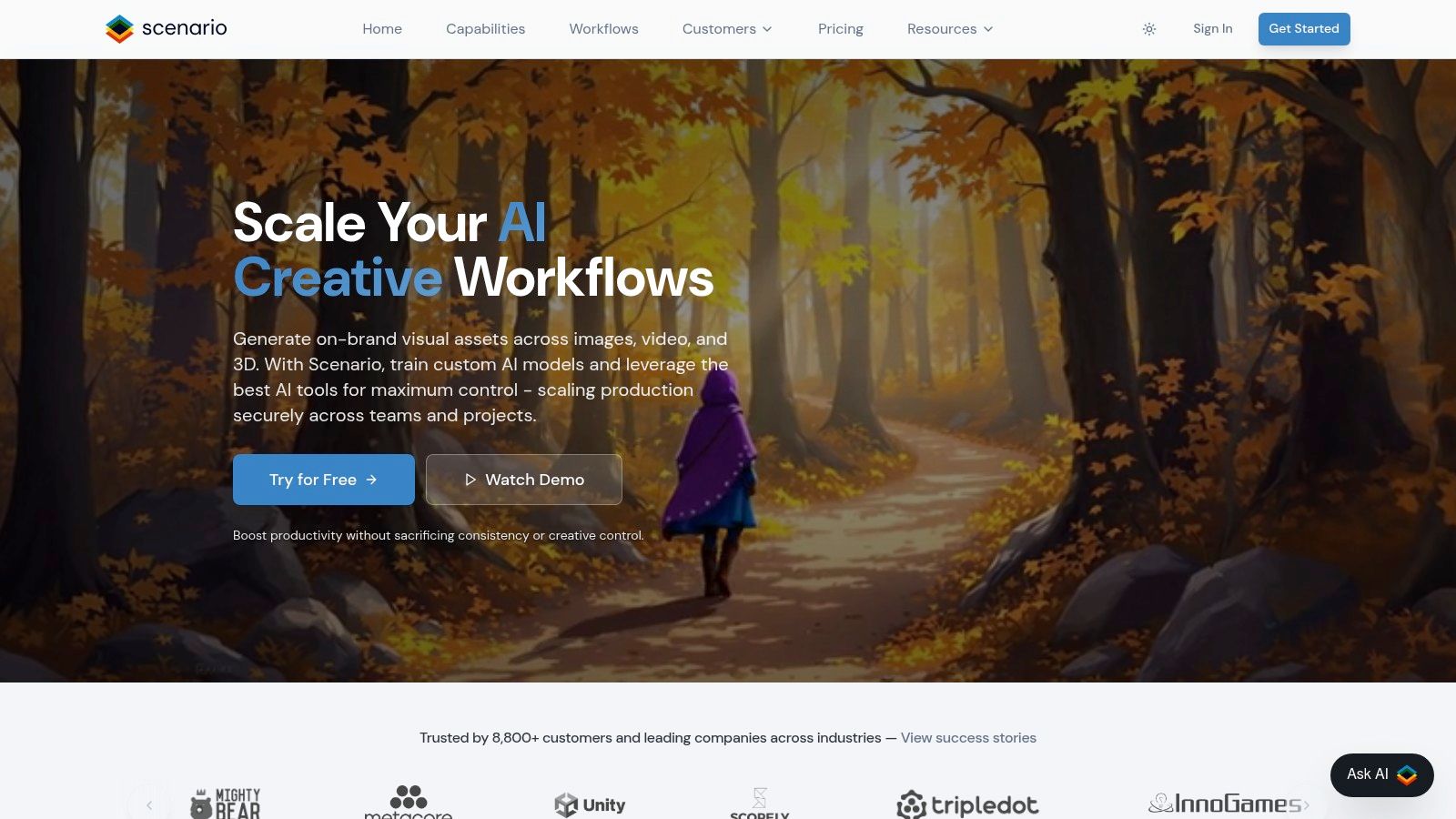
The platform stands out by offering features directly relevant to game pipelines, including image-to-3D asset creation and advanced controls for composition. Scenario also supports team and enterprise-level workflows, with clear API documentation that facilitates integration into existing pipelines for automated content creation. This focus on consistency and integration makes it one of the most practical AI tools for game development studios aiming to scale their art production responsibly.
Key Considerations
- Pricing: Offers a tiered subscription model, including a free starting plan. Paid plans are based on compute quotas and the number of custom models a team can train.
- Quality Control: The quality of outputs is directly tied to the training data provided by the studio. High-quality, consistent input data is essential for achieving desired results.
- Usage Limitations: The platform operates on a credit-based system (compute quotas), which can limit high-volume generation on lower-tier plans. Heavy model training may necessitate a higher-tier subscription for sufficient resources.
Website: https://www.scenario.com/
7. Leonardo.Ai
Leonardo.Ai has rapidly become a go-to platform for generating high-quality game assets, including concept art, UI elements, and marketing materials. It distinguishes itself with powerful features like custom model training, which allows studios to create assets in a consistent, proprietary art style. For teams, its shared workspaces and organised asset libraries make it one of the most practical AI tools for game development, facilitating collaboration and project management directly within the platform.
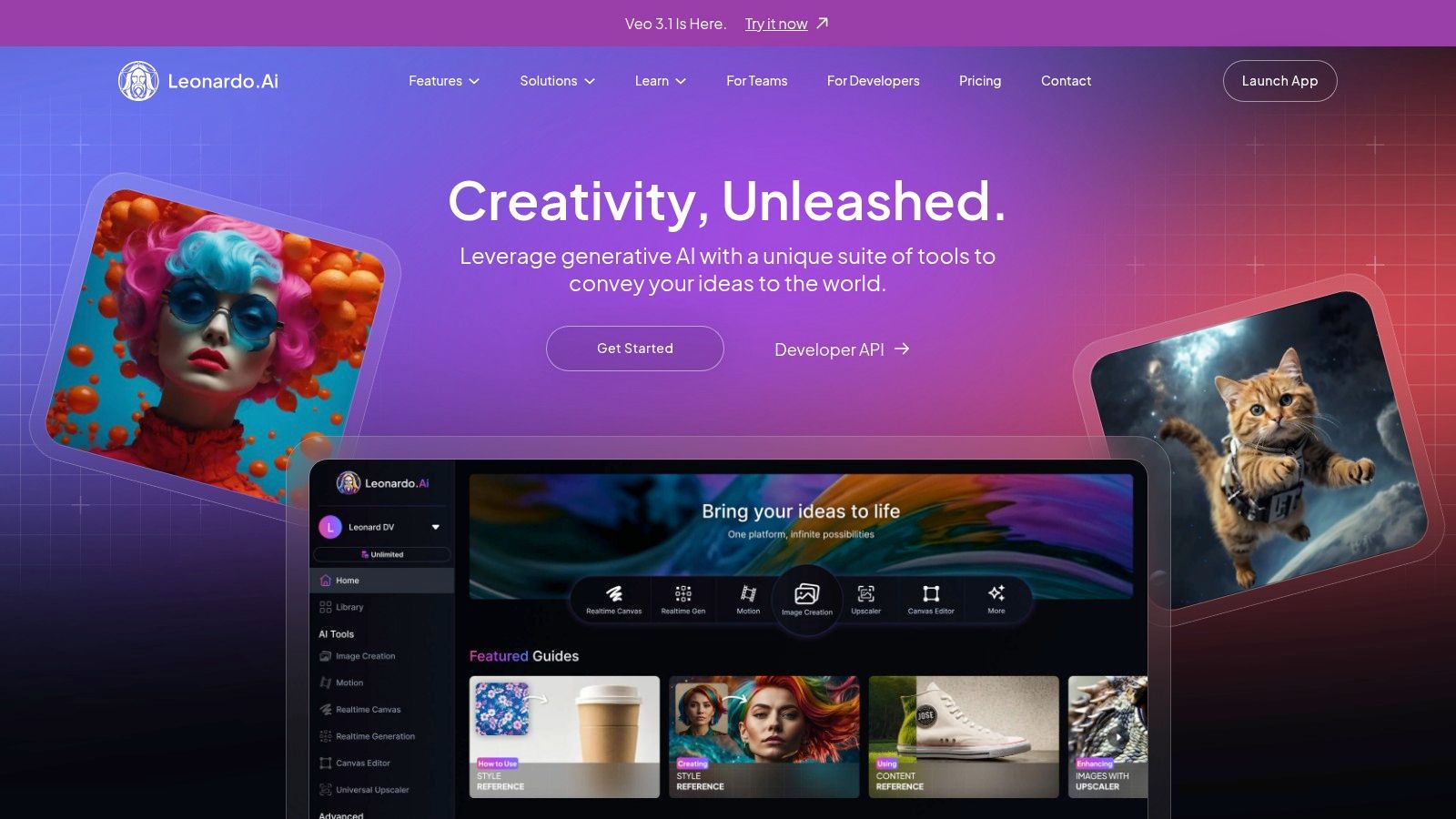
The platform’s clear commercial use terms and enterprise-friendly tiered plans offer a compliant and scalable solution for professional studios. Its API also enables automation, allowing for integration into existing pipelines for tasks like procedural texture generation. This focus on team features and clear usage rights makes it an excellent choice for studios that need to manage visual asset creation at scale while maintaining control over their creative IP.
Key Considerations
- Pricing: A token-based system with a generous free tier. Paid plans unlock faster generation, private creations, custom model training, and larger team sizes.
- Quality Control: The platform offers various generation models and community-trained "Blueprints" that deliver consistent, high-quality results. Private model training provides the highest level of artistic control.
- Usage Limitations: The free plan’s relaxed generation mode can be slow during peak times. Advanced features like API access and larger team collaboration are reserved for higher-tier paid subscriptions.
Website: https://leonardo.ai/
8. ElevenLabs
For game studios seeking to generate high-quality voice-overs, dialogue, and narration, ElevenLabs has become an industry-standard AI tool for game development. Its text-to-speech (TTS) and voice cloning capabilities deliver studio-grade audio, allowing developers to rapidly prototype and finalise voice lines for NPCs or create localised audio tracks without booking expensive talent. The platform is built around a powerful API, designed for easy integration into existing game development pipelines and tools, enabling dynamic dialogue generation in real time.
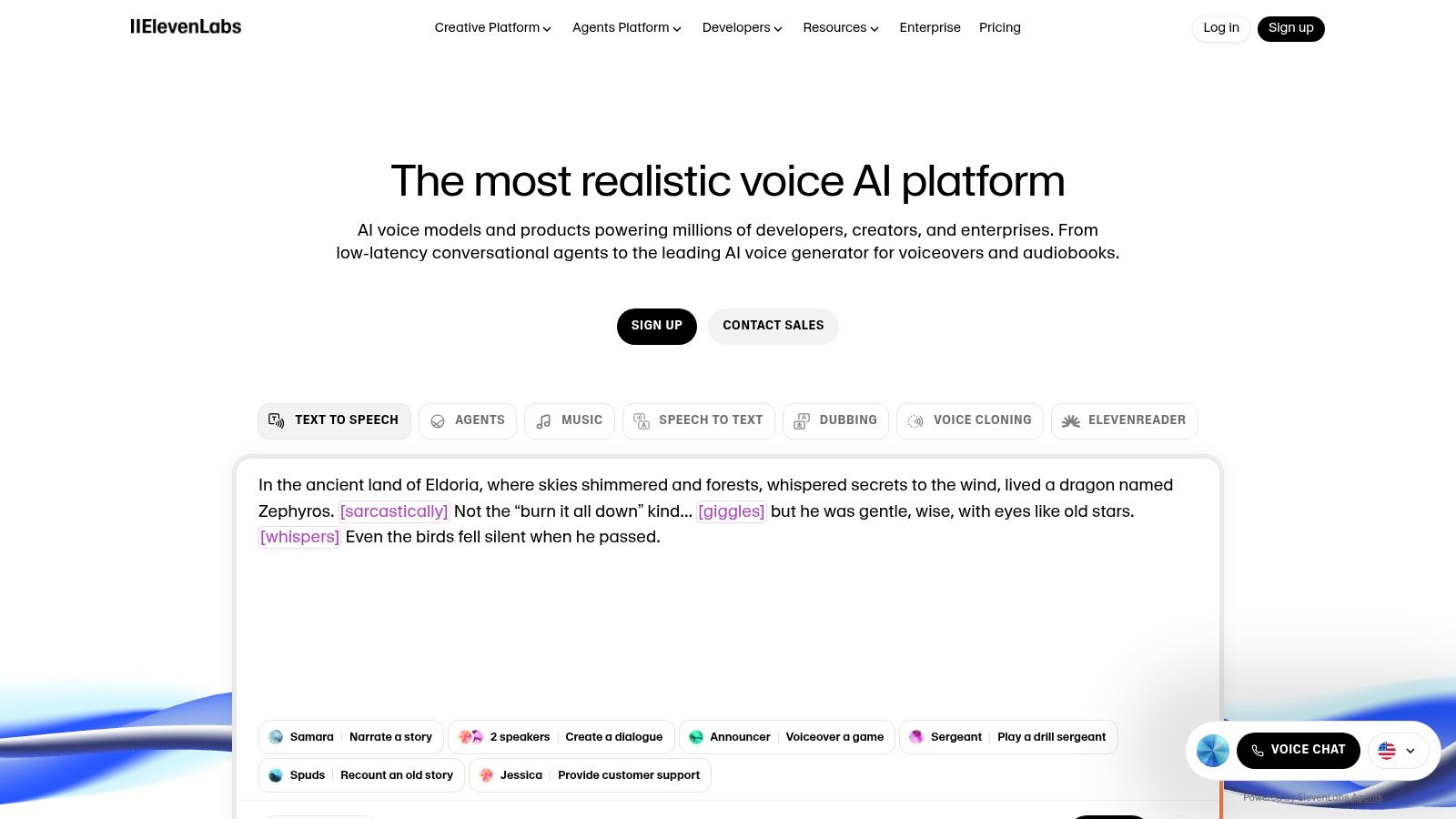
ElevenLabs stands out for its exceptionally natural-sounding voices and robust multilingual support, making it a go-to solution for global game releases. Its clear, usage-based credit system and enterprise-ready features provide the scalability and predictability needed for commercial projects. The recent introduction of conversational AI agents further extends its utility, enabling the creation of truly interactive characters.
Key Considerations
- Pricing: Operates on a tiered subscription model based on monthly character credits and agent minutes. A free plan is available with starter credits for initial testing and small projects.
- API and Throughput: While the API is well-documented, lower-tier plans have concurrency throttles that can limit the throughput for large-scale, real-time generation tasks.
- Agent Costs: When using conversational agents, the costs associated with the underlying Large Language Model (LLM) may be separate from the ElevenLabs usage credits, requiring careful budget management.
Website: https://elevenlabs.io/
9. Meshy
Meshy is a browser-based 3D creation platform designed for rapidly generating game-ready assets from simple text or image prompts. It serves as a powerful accelerator for 3D artists and developers, allowing them to produce meshes, textures, and even basic animations with impressive speed. The platform's standout feature is its end-to-end workflow, which includes AI texturing, automatic rigging, and a library of motions that can be applied to generated models, making it one of the more comprehensive ai tools for game development.
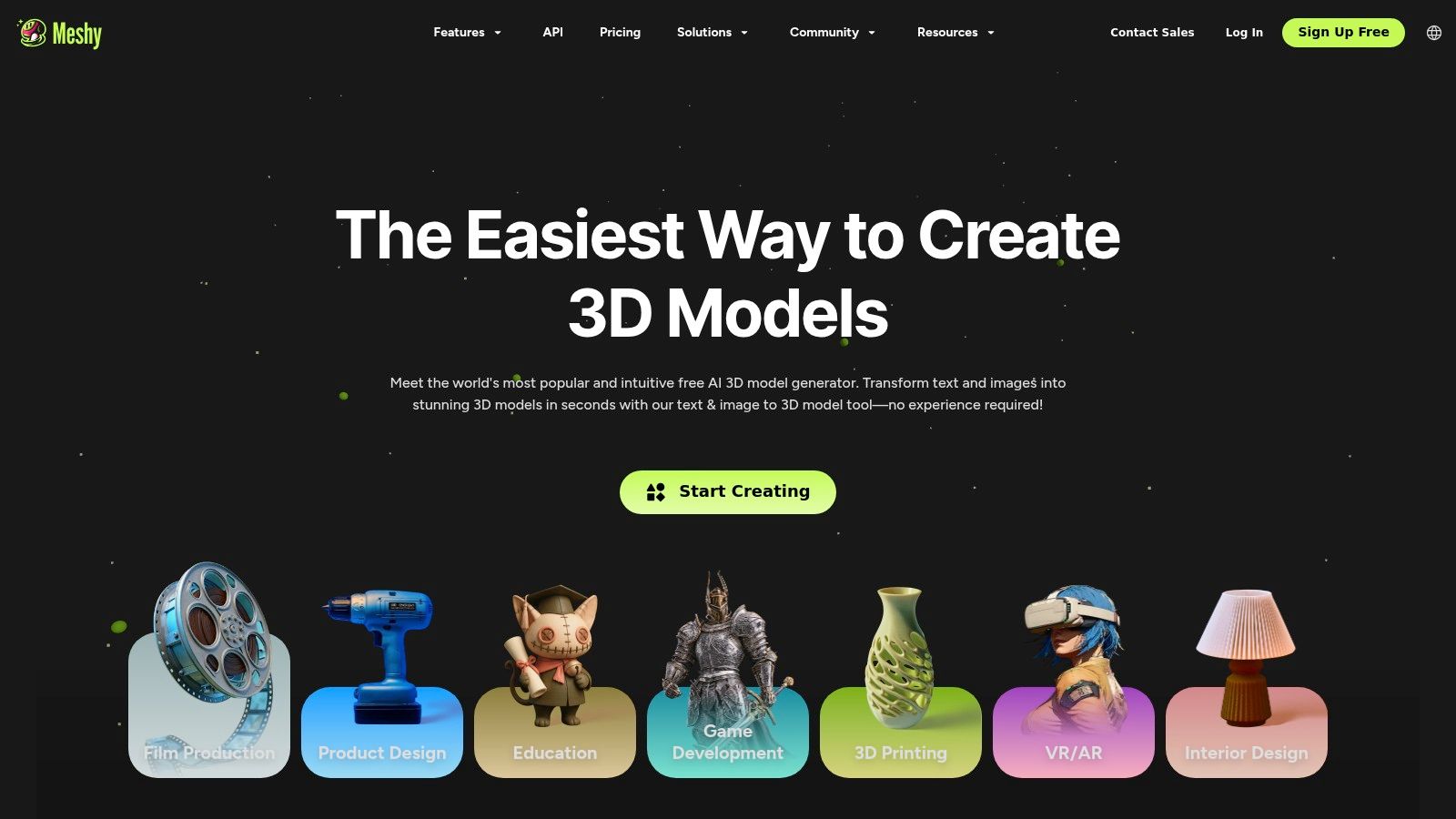
It particularly shines in its practical application for enterprise teams, offering team workspaces and API access for pipeline integration. This focus on utility over novelty allows studios to prototype visual props and characters quickly, validating creative concepts without committing significant artist resources. You can learn more about how to generate 3-D models with AI to understand the technology's potential.
Key Considerations
- Pricing: Offers a free tier with limited monthly credits and a CC BY 4.0 licence on assets. Paid plans provide private assets, higher throughput, and team-focused features.
- Quality Control: The platform includes useful tools like remeshing and asset retopology to refine the initial AI output, giving artists more control over the final quality.
- Usage Limitations: Commercial use and private ownership of generated assets are restricted to the paid subscription tiers, a crucial consideration for professional projects.
Website: https://www.meshy.ai/
10. NVIDIA Omniverse Audio2Face
NVIDIA's Omniverse Audio2Face is a specialised AI tool that tackles one of game development's most time-consuming visual tasks: generating realistic facial animations from audio. By feeding it a simple audio track, the application automatically creates expressive lip-sync and emotional facial movements for 3D characters. It is particularly powerful for studios working with digital humans, offering seamless retargeting to popular rigs like MetaHuman, which significantly accelerates dialogue-heavy scene creation.

This platform excels by providing deep, granular control over the final animation. Unlike black-box solutions, developers can adjust parameters for everything from eye movement and tongue placement to the intensity of specific emotions. This level of customisation ensures that the AI-generated output serves as a high-quality baseline that can be refined to meet the artistic direction of any project, making it a powerful addition to modern AI tools for game development.
Key Considerations
- Pricing: The Omniverse platform, including Audio2Face, is free for individual creators and artists. Enterprise licensing is required for larger teams and commercial use.
- Quality Control: The quality is consistently high, but achieving the best results requires NVIDIA RTX hardware. The toolset is robust, but launcher updates or framework changes can sometimes affect established workflows.
- Usage Limitations: The tool is designed for generating animation data. Users should consult NVIDIA's licensing agreements for specifics on commercial use and redistribution of assets created with the tool.
Website: https://docs.omniverse.nvidia.com/audio2face/latest/
11. Cascadeur
Cascadeur is a standalone software dedicated to supercharging character animation through AI-assisted tools. It focuses on accelerating the traditionally laborious process of keyframe animation by using AI to suggest natural poses, predict physically accurate movements, and intelligently fill in the gaps between keyframes. This makes it one of the most practical AI tools for game development for teams aiming to produce high-fidelity, realistic character animations without the budget for extensive motion capture or a large animation team.
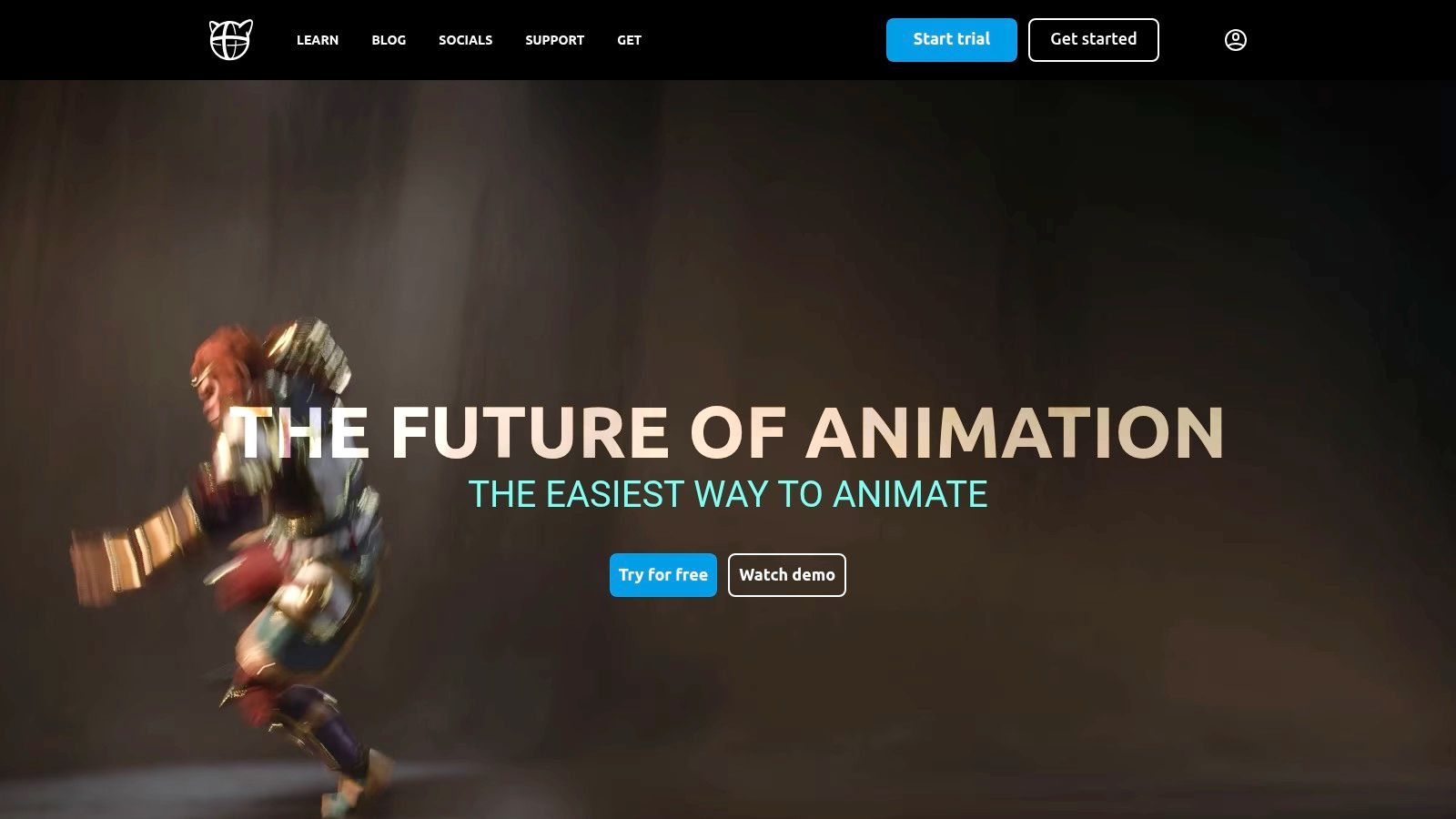
The platform stands out by blending deep physics-based calculations with creative control, allowing animators to guide the AI rather than be replaced by it. Its AutoPhysics tool can instantly create a physically correct version of an animation, while its AutoPosing feature helps find natural-looking stances for character rigs. The clear commercial licensing on its paid tiers also makes it a safe and compliant choice for professional studios and enterprise projects that require transparent usage rights.
Key Considerations
- Pricing: Offers a free version for learning and small projects. Paid tiers include Indie, Pro, and Teams plans with perpetual licences and subscription options for updates, catering to various commercial needs.
- Quality Control: While powerful, new users should anticipate a learning curve to fully leverage its unique physics-based workflow. The tool is highly optimised for humanoid characters, and its effectiveness may vary with non-humanoid rigs.
- Usage Limitations: The free licence has specific revenue and team size restrictions. Commercial use requires upgrading to a paid plan, which is essential for enterprise compliance and legal protection.
Website: https://cascadeur.com/
12. AWS for Games (Amazon)
For studios aiming to build custom, production-grade AI solutions, AWS for Games offers a comprehensive suite of cloud services and reference architectures. Instead of a single tool, it provides the fundamental building blocks-like Amazon Bedrock for generative AI and SageMaker for ML workloads-that empower developers to create bespoke AI functionalities. This makes it one of the most powerful and scalable ai tools for game development, ideal for features such as dynamic NPC dialogue, procedural visual content generation, or real-time game analytics.
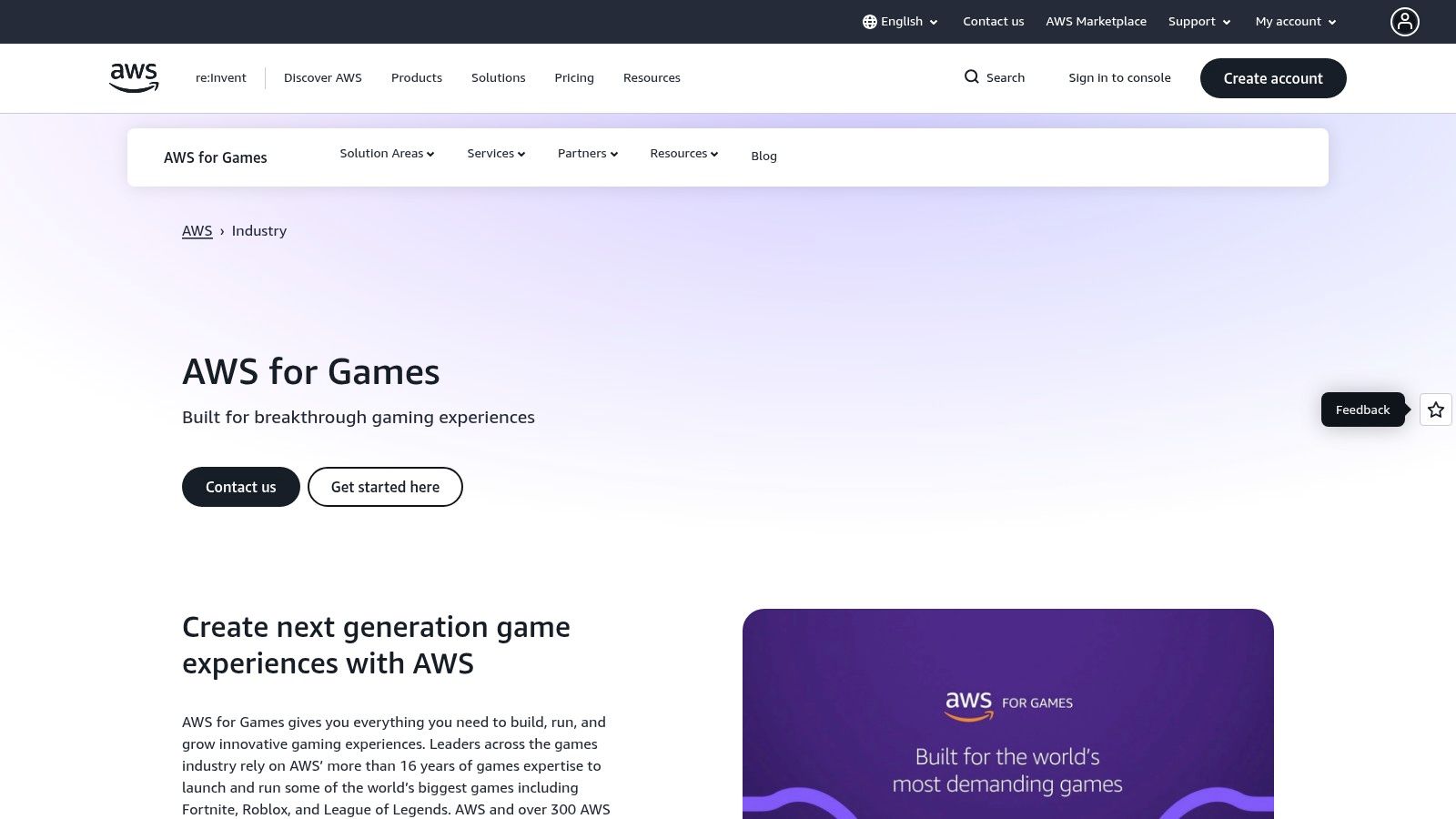
The platform's strength lies in its production-ready infrastructure and detailed solution guides tailored for the games industry. AWS provides sample code and architectural patterns for common use cases, like generative NPC dialogue or adaptive music, which helps enterprise teams accelerate development while ensuring their solutions are secure, scalable, and compliant with global standards.
Key Considerations
- Pricing: Operates on a pay-as-you-go model. This allows for flexible investment but requires careful cost monitoring to avoid unexpected expenses.
- Quality Control: As a collection of enterprise-grade services, the quality is consistently high. However, the final implementation quality depends entirely on the development team's expertise.
- Usage Limitations: Requires significant engineering effort to integrate the various services into a cohesive game development pipeline. It is a collection of building blocks, not an out-of-the-box toolset.
Website: https://aws.amazon.com/games/
Top 12 AI Tools for Game Development: Feature Comparison
Choosing Your Studio's Next Creative Partner
The landscape of game development is undergoing a seismic shift, powered by the integration of sophisticated AI tools. As we have explored, platforms ranging from Scenario’s consistent visual asset generation to Cascadeur’s physics-based animation and ElevenLabs's hyper-realistic voice synthesis are not just augmenting workflows; they are fundamentally redefining creative possibilities. Moving beyond isolated solutions, marketplaces like Unity’s Asset Store and the unified Epic Games Fab are centralising access, while specialised tools such as Inworld for NPCs and modl.ai for QA are solving industry-specific challenges.
This evolution brings immense opportunity, but it also demands a strategic, holistic approach. The real challenge is not merely adopting these technologies but weaving them into a cohesive, secure, and efficient pipeline. The era of fragmented toolchains and disjointed workflows is proving unsustainable for studios aiming to scale production without compromising quality or security.
Key Considerations for Integrating AI Tools
When evaluating which AI tools for game development best suit your studio, consider these critical factors beyond the feature list:
- Intellectual Property and Security: Where is your data being processed? Who owns the generated assets? Prioritise platforms that offer clear IP ownership and enterprise-grade security protocols to protect your most valuable creative assets.
- Workflow Integration: How seamlessly does a new tool fit into your existing pipeline with engines like Unity or Unreal? Look for robust APIs, SDKs, and integrations that minimise friction and avoid creating new data silos. A tool that saves time in one area but creates bottlenecks elsewhere is not a true solution.
- Scalability and Team Collaboration: Can the tool support a growing team of artists, designers, and developers? Features like shared libraries, version control, and centralised feedback mechanisms are crucial for maintaining creative coherence as projects expand.
- Talent and Training: Adopting new technology requires skilled personnel. You may need to upskill your current team or bring in specialised expertise. When considering external support for your AI initiatives, a detailed guide on choosing a staff augmentation company for AI talent can be invaluable.
The Future is a Unified Creative Ecosystem
The ultimate goal is to build an environment where creativity can flourish without being hampered by technical or administrative overhead. This is where the concept of a Creative Operating System becomes paramount. By centralising visual asset generation, management, and review into a single, secure hub like Virtuall, studios can establish a "single source of truth." This organised approach ensures that every model, texture, and animation is tracked, versioned, and compliant from inception to final implementation.
Adopting such a system transforms your studio from a collection of individual creators using disparate tools into a unified creative force. It empowers your team to innovate confidently, knowing their work is protected and their workflow is optimised for collaboration. By making a strategic choice today, you are not just selecting a tool; you are investing in a future where you can build the next generation of immersive gaming experiences faster, smarter, and more securely.
Ready to unify your creative pipeline and unlock the full potential of AI in a secure, collaborative environment? Explore how Virtuall acts as your studio's Creative OS, centralising asset generation and management to accelerate your game development workflow. Visit Virtuall to discover a smarter way to create.

